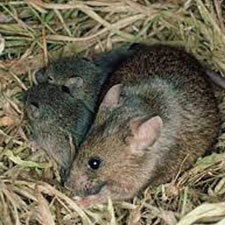 Wild mice
Wild mice
Common name: Mice
Botanical name: Mus musculus
Management programme: Advisory
Where are they originally from?
- Introduced via whaling ships and ships carrying early European settlers.
- The first mouse arrived in New Zealand via Australia when the ship ‘Henrietta’ ran ashore on Ruapuke Island off Stewart Island in 1824. Found to be stabilised in the Bay of Islands around 1830.
Why are they a pest?
- Mice prey on native species and compete for food with them.
- Eat just about anything including invertebrates,. seeds, fruits, leaves, eggs, chicks and insect larvae.
- They can affect every part of the ecosystem
- Mice can be a real problem in homes, cities and farms.
Where are they found?
Mice can live in all New Zealand habitats. They are commonly found in overgrown areas where they have protection from predators and are common home invaders.
What do they look like?
- A small grey, brown furry rodent whose body is about 10cm long with a long thin tail.
- Long whiskers and has a white, grey or brown belly.
- Very small footprints and can look like scattered dots.
- Produce very small elongated droppings.
What are the rules?
Advisory
Council does not enforce the control of advisory species. It is landowner/occupier responsibility to manage these pests. Council may provide advice on how to manage or control advisory species if required.
How do you get rid of them?
- Trapping
- Poisoning
CAUTION: When using pesticide please READ THE LABEL thoroughly to ensure that all instructions and safety requirements are followed. When using traps please ensure that all instructions, safety requirements and laws (in particular the Animal Welfare Act 1999) are followed.
NAWAC (National Animal Welfare Advisory Committee) approved kill traps need to be set as per the manufacturers guidelines.
Guidelines on trap use https://www.mpi.govt.nz/animals/animal-welfare/animal-welfare-and-pest-management/traps-and-devices/
DISCLAIMER: Information in this fact sheet regarding pesticides does not necessarily appear on the labels of the products concerned. Bay of Plenty Regional Council does not accept liability for any damage that may arise from the use of pesticides at non-standard rates. Mention of product trade names implies neither endorsement of those products nor criticism of similar products not mentioned. Bay of Plenty Regional Council does not accept liability for any damage or injury that may arise from the use of traps, toxins and firearms.
Read more on pest control guidelines and regulations

Image credit: DOC
